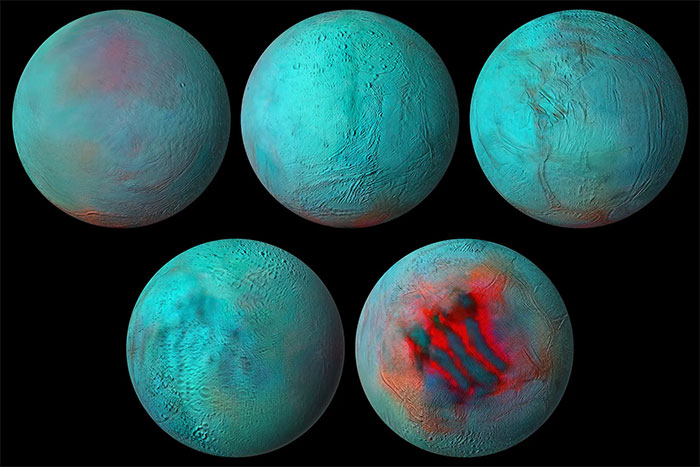Alien abyss reveals signs of potential life
Subtle movements on the surface of an alien world could be evidence of an ocean teeming with life .
Scientists from the California Institute of Technology (Caltech - USA) have revealed that side-by-side gliding motion along distinctive "tiger stripes" on Saturn's moon Enceladus could be a sign of a world filled with life. living.
The "tiger stripes" consist of four nearly parallel cracks at the south pole of Enceladus , first observed by NASA's Cassini spacecraft in 2005.

Infrared global map of Enceladus taken from different sides, in which images taken from the South Pole clearly show giant "tiger stripes" - (Photo: NASA).
"Ice volcanoes" in this area explode ice crystals believed to originate from the underground ocean in these cracks, creating a large plume that shoots up near the South Pole.
The brightness of these plumes and of each individual jet appears to vary over Enceladus's 33-hour orbit around Saturn.
This led scientists to hypothesize that the activity of these water jets is influenced by tidal forces.
That is a good sign, because the existence of tides shows that the underground ocean below this celestial body's ice shell can be warmed, as well as have the chemical composition necessary to maintain life.
However, this theory cannot explain why Enceladus's flares peaked a few hours after tidal pressure reached its maximum or why there was a second, slightly smaller, powerful eruption immediately after. when Enceladus makes its closest approach to Saturn.
Numerical simulations from Caltech of Enceladus's tidal stress and the motion of its tiger-striped faults identify a phenomenon similar to that seen on the US San Andreas fault.
The authors found that frictional mechanics drives motion in the interfaces along Enceladus' tiger stripes where both sides of the crack meet.
The correlation between strike-slip activity and jet brightness in the simulation led the team to hypothesize that jet variability is controlled by the presence of 'drag zones' along the fault.
These are bent parts of the cracks, which open under a broad horizontal strike motion, allowing water to rise from the subsurface ocean to penetrate the icy crust to feed the cold jets.
The model also shows that this side-slip movement is also due to the extremely strong tides below.
'Understanding the transport pathways of subsurface material through rifting or rifting zones is important for determining whether ice grains in Enceladus' jets are representative of a possible global ocean habitable or not" - Dr. Alexander Berne, head of the research team, told Live Science.
Evidence of the long-term influence of tides on Enceladus's evolution, which also heats the interior, implies that the moon's ocean has been long-lived.
This means life also has the opportunity to grow and evolve strongly inside this interesting world.
Of course to confirm that life 100%, we need to wait for direct explorations.
Believing that Enceladus has life, NASA is developing a snake-shaped robot that is expected to reach the moon in the future, crawling into cracks to search for evidence of life in the underground ocean.
- Hunt for aliens by wavering
- Stunned with a new announcement about alien life signs
- 'Ghosts' gas reveals traces of alien creatures?
- New direction to search for alien life
- With this situation, even if we find aliens, we are not sure
- Stunned new alien life exploration tool
- NASA has acknowledged the existence of aliens
- Alien life can be discovered in the next 20 years
- The lake nearly 3 billion years can contain alien life
- Sometimes we have discovered the trace of aliens already, just do not know what it is
- Detecting signs of life on Pluto
- New way to study alien life
 Van Allen's belt and evidence that the Apollo 11 mission to the Moon was myth
Van Allen's belt and evidence that the Apollo 11 mission to the Moon was myth The levels of civilization in the universe (Kardashev scale)
The levels of civilization in the universe (Kardashev scale) Today Mars, the sun and the Earth are aligned
Today Mars, the sun and the Earth are aligned The Amazon owner announced a secret plan to build a space base for thousands of people
The Amazon owner announced a secret plan to build a space base for thousands of people